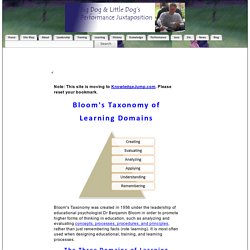

2012-06-25_10-18-47. Start Here - Overview of Bloom's Taxonomy. Blooms Taxonomy Action Verbs. Bloom’s Taxonomy. By Patricia Armstrong, Assistant Director, Center for Teaching Background Information In 1956, Benjamin Bloom with collaborators Max Englehart, Edward Furst, Walter Hill, and David Krathwohl published a framework for categorizing educational goals: Taxonomy of Educational Objectives.

Familiarly known as Bloom’s Taxonomy, this framework has been applied by generations of K-12 teachers and college instructors in their teaching. The framework elaborated by Bloom and his collaborators consisted of six major categories: Knowledge, Comprehension, Application, Analysis, Synthesis, and Evaluation. Bloom's Taxonomy of Learning Domains. Note: This site is moving to KnowledgeJump.com.

Please reset your bookmark. Bloom's Taxonomy was created in 1956 under the leadership of educational psychologist Dr Benjamin Bloom in order to promote higher forms of thinking in education, such as analyzing and evaluating concepts, processes, procedures, and principles, rather than just remembering facts (rote learning). It is most often used when designing educational, training, and learning processes. Bloom's Digital Taxonomy.